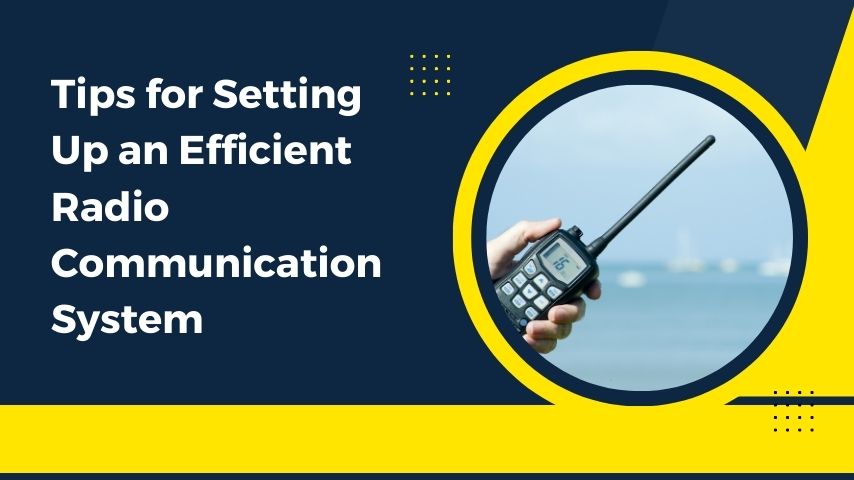Setting up an efficient radio communication system is essential for various sectors, including emergency services, businesses, and outdoor activities. A well-designed radio communication system ensures clear and reliable communication, which is critical for safety, coordination, and overall efficiency. In this guide, we will cover the essential tips for setting up an efficient radio communication system. From understanding the basics to choosing the right equipment and maintaining your system, we will provide you with the information you need to get started.
Understanding the Basics of Radio Communication Systems
Before diving into the setup process, it’s important to understand the basics of radio communication systems. These systems use radio waves to transmit voice or data between two or more devices. The main components of a radio communication system include a transmitter, a receiver, and an antenna. The transmitter sends out radio waves, which are picked up by the receiver through the antenna. This allows for communication over various distances, depending on the system’s power and frequency.
Radio communication systems can be either analog or digital. Analog systems use continuous signals to transmit information, while digital systems convert information into binary code (1s and 0s) before transmitting it. Digital systems offer better sound quality, increased security, and more efficient use of the radio spectrum.
Note – Ready to enhance your communication capabilities? Look no further than SoyuzTech for your Radio Communication System needs. Our expert team provides top-quality solutions tailored to your specific requirements. Contact SoyuzTech today to explore our range of products and services, and get a free consultation! Elevate your communication efficiency now with SoyuzTech.
Choosing the Right Equipment
Choosing the right equipment is crucial for setting up an efficient radio communication system. The first step is to determine your specific needs and requirements. Consider factors such as the environment in which the system will be used, the distance over which communication is required, and the number of users. This will help you select the appropriate type of radio system and equipment.
Handheld radios, also known as walkie-talkies, are portable and convenient for short-range communication. They are ideal for use in small businesses, outdoor activities, and emergency situations. Mobile radios, on the other hand, are installed in vehicles and provide longer-range communication. They are commonly used by public safety agencies, transportation companies, and utility services. Base station radios are fixed units that offer even greater range and are typically used in dispatch centers and control rooms.
In addition to the radios themselves, you will need to select the right accessories to enhance your system’s performance. Antennas are a critical component, as they determine the range and clarity of your communication. Make sure to choose an antenna that is compatible with your radio system and suited for your specific needs.
Setting Up Your Radio Communication System
Once you have selected the right equipment, it’s time to set up your radio communication system. Start by finding the optimal locations for your radios and antennas.

Next, program your radios to the appropriate frequencies and channels. Most modern radios allow you to customize the settings to suit your specific needs. This includes selecting the right frequency band (VHF or UHF), setting up privacy codes to prevent interference from other users, and configuring features such as scan and priority channels.
Maintaining Your Radio Communication System
Maintaining your radio communication system is essential to ensure its long-term efficiency and reliability. Regular maintenance will help prevent issues and extend the lifespan of your equipment. Start by keeping your radios and accessories clean and free of dust and debris. Use a soft cloth and a mild cleaning solution to wipe down the devices, and make sure to keep the connectors and antenna contacts clean.
Inspect your equipment regularly for signs of wear and tear. Check the antennas for any damage or corrosion, and replace them if necessary. Inspect the batteries and chargers to ensure they are functioning properly. If you notice any issues with your radios, such as reduced range or poor sound quality, troubleshoot the problem and perform any necessary repairs or replacements.
Another important aspect of maintenance is keeping your software and firmware up to date.
Training and Best Practices
Training your team on the proper use of the radio communication system is crucial for its efficiency. Make sure that all users are familiar with the basic operation of the radios, including how to turn them on and off, change channels, and use any special features. Conduct regular training sessions to reinforce best practices and ensure that everyone is comfortable using the equipment.
Establish clear communication protocols and procedures for your team. Encourage users to speak clearly and concisely, and to avoid unnecessary chatter that could interfere with important communication.
Finally, develop a plan for dealing with emergencies and unexpected situations. This should include procedures for reporting and responding to issues with the radio communication system, as well as contingency plans for maintaining communication in the event of equipment failure.
Conclusion
Setting up an efficient radio communication system requires careful planning, the right equipment, and ongoing maintenance. By understanding the basics of radio communication, choosing the right equipment, and following best practices for setup and maintenance, you can create a system that meets your needs and ensures clear and reliable communication.
For more insightful articles related to this topic, feel free to visit technewsideas.com


